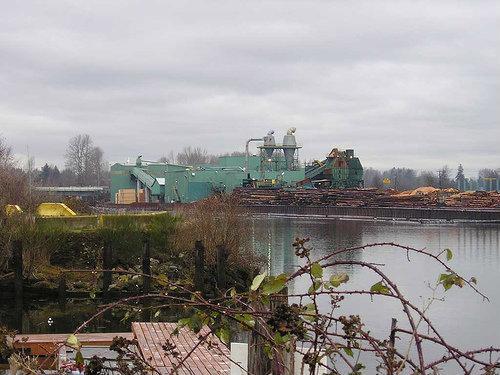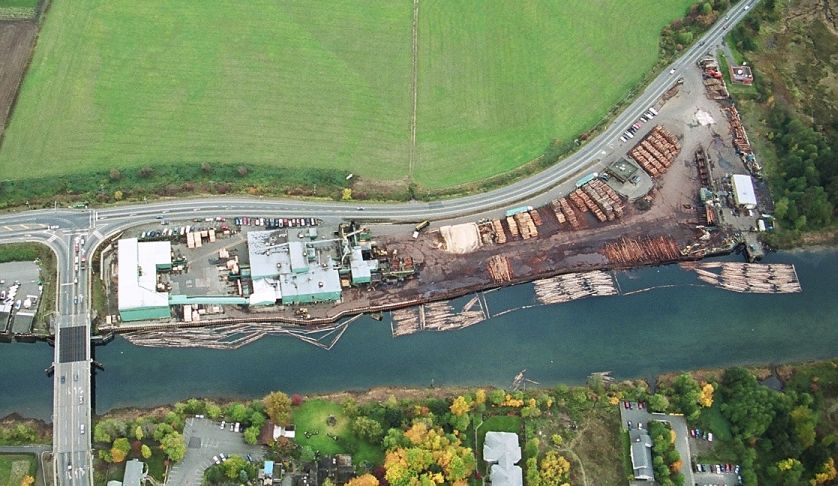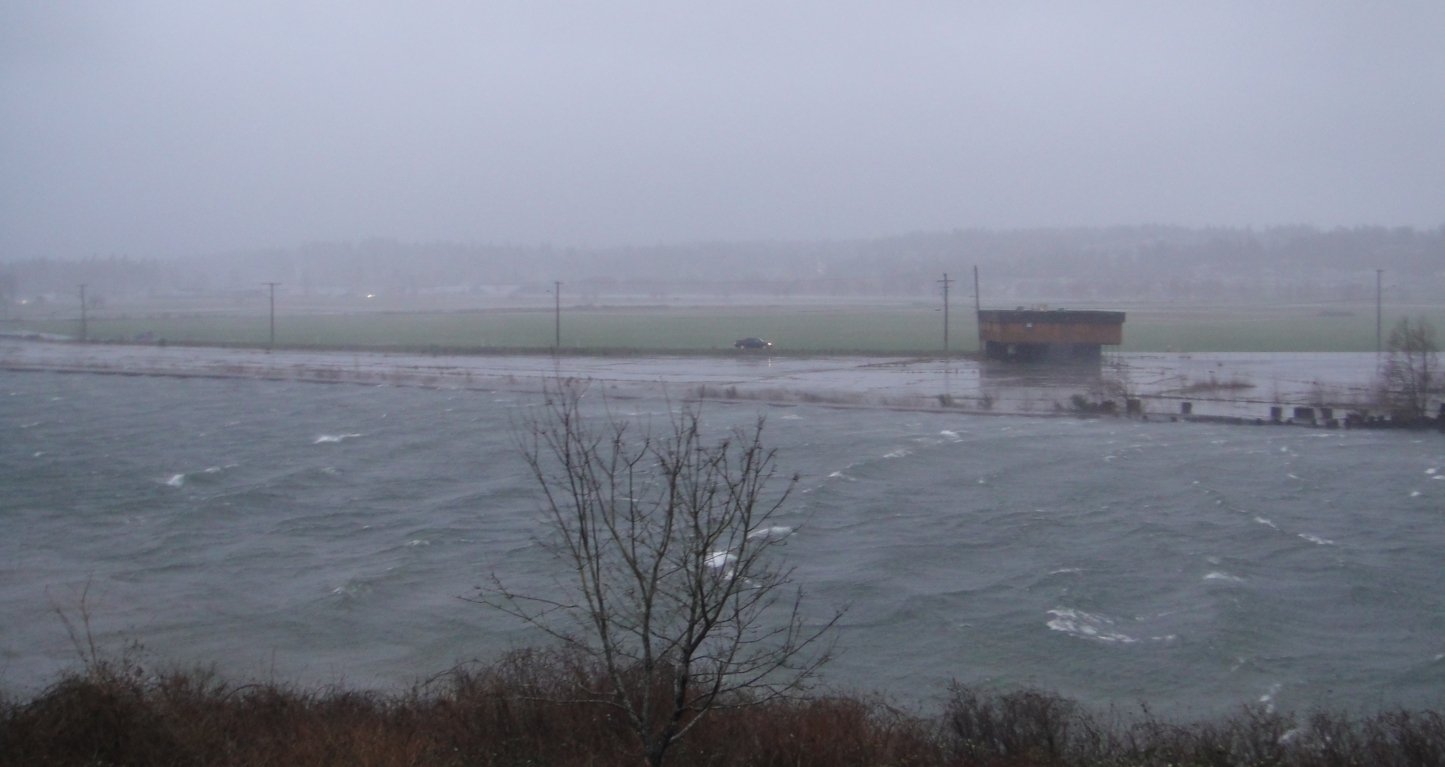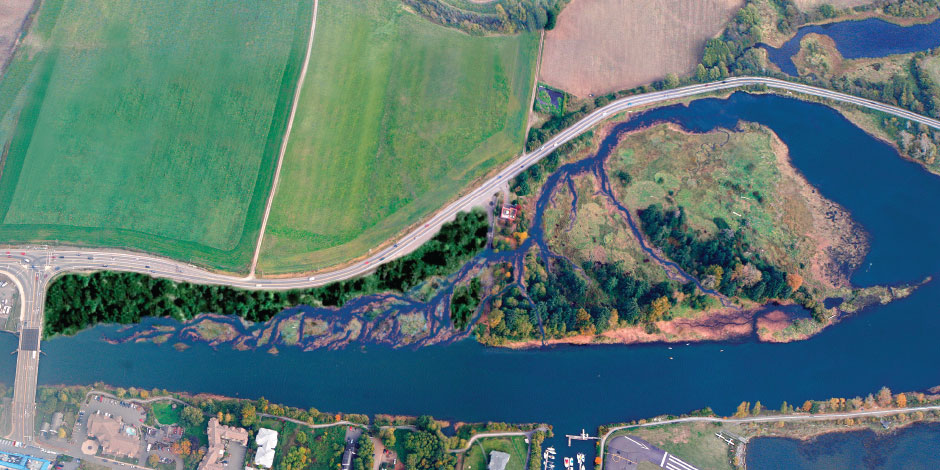History of the Field Sawmill Site/Kus-kus-sum
1931
1950
1980’s
2010 – On-Site Flooding
Artistic Rendition of Kus-kus-sum Post Restoration ~ Robert Lundquist
The Kus-kus-sum site is located on the northern riverside of the Courtenay River at the confluence of the river and the K’ómoks Estuary. Historical aerial photographs from the 1930’s show that the site was initially tidally influenced forested riverside/riparian habitat. Records from European settlement also indicate that this side of the river, and likely the current Kus-kus-sum site itself, held mortuary trees and were burial grounds for the Kus-kus-sum village. The presence and location of burial trees was not extensively documented, and they may have extended along the lower part of the river.
The Kus-kus-sum village, which was across the river roughly in the area where the present-day Courtenay Airpark is now located, is the namesake for the present day Kus-kus-sum site. The term Kus-sum means slippery and Kus-kus-sum, means very slippery, likely in reference to the algae that existed on the shores around the village.
The Field family retired the mill in 1969 selling it to Errol Zinck and Bill Phillips, two employees at the time (“A Look Back into The History of The Comox Valley, Field Sawmill”, 2013).
In the 1970’s, the mill owners were filling the marsh area between Courtenay River and Comox Rd, with an assortment of chips, oil cans and wire etc. Concerned residents stopped this and the landfilling was halted. In 1974, the Provincial NDP government paid $95,850 for 25.5 acres to prevent the owners at the time from destroying what is now called Hollyhock Marsh, reports Betty Donaldson (2010).
The owners of the mill sold it to Peter Gregory of Gregory Manufacturing Ltd. in 1973. Gregory then sold the mill to Primex Forest Products. The mill at that time was cutting and selling lumber (yellow) cedar to both the American and the Japanese markets. In the 1970s, the operation employed over 100 people and, at its peak 160.
In 2000, Primex started facing economic problems and began employee lay-offs. In 2001 Interfor bought out Primex and acquired the Fields Sawmill. The Mill experienced hard times again in 2003 – 2004. The mill closed often and in 2003 it operated at a loss of $8 million. The mill was decommissioned and closed officially in 2006.
In 2006, Interfor demolished the mill, auctioned off the equipment, and paid out severance to its employees. At this time, reclamation of the site was also undertaken to safely remove and dispose of industrial toxins. A number of test wells were drilled to determine the quantity and nature of toxic materials in the soils. Concrete was broken up, and toxic soils were excavated and removed from the site. The holes were backfilled with clean soils and the wells tested again to verify the site was reclaimed. The Province issued a Certificate of Compliance, verifying that the site now meets the highest standards.
The property was offered for sale in 2008.
Despite several offers to purchase, Interfor has chosen to work with Project Watershed and the larger community to achieve a conservation vision for the property.
In 2011, Project Watershed supported a study which prioritized a list of restoration projects to increase the health and productivity of the K’ómoks Estuary for salmonids. Again, the idea of purchasing and restoring the site came forward and was listed as a top priority. The cost to purchase and restore the site was the main constraint and while the idea was of interest to the City of Courtenay, they had no funds to support it.
In 2014 ,Project Watershed was in touch with Tim Ennis, who had been integral in successfully managing a similar project, the purchase and restoration of a Campbell River lumber sort to natural estuarine habitat. Tim was onside with the restoration of the sawmill and later became a main player in the process. Conversations with the K’ómoks First Nation confirmed that Project Watershed’s proposal to purchase and restore the land was in line with the vision and that they supported moving forward. The new City of Courtenay Council was also supportive of the idea, although they needed more information to formally endorse it. With this support behind them Project Watershed began discussions with Interfor Corporation, who owned the site, and ascertained that they too, were open to and supportive of a conservation solution for the land.
In 2017, based on a third-party assessment of the property’s value Project Watershed and Interfor agreed to a sale price and timeframe to gather the funds for purchasing the site. In September of that year, Project Watershed officially launched the initiative to purchase and restore the Kus-kus-sum site, with the support of the K’ómoks First Nation and City of Courtenay. Project Watershed made the first down payment in 2017 to Interfor via a personal contribution of $20,000 from Bill and Valeri Heath. In 2018, $700,000 in payments were made to Interfor via contributions from granting agencies as well as individuals and businesses of the Comox Valley. By the end of 2019, $1.5 M in payments had been made to Interfor Corporation, $1 M of which came from the Province of BC. In November 2020, Project Watershed succeeded in raising the remainder of the funds required for the purchase of the site with the Province of BC stepping in at the final hour to contribute $600,000.
Human Resources
Related Posts
Gwen Janz
Meet our new Forage Fish Lead Biologist!
Eelgrass Update
In the fall our restoration team surveyed the three eelgrass beds which were planted with the help of our volunteers back in June. The beds are looking healthy!
Kus-kus-sum: End of Season Wrap-up
Now that we have put the Kus-kus-sum site to bed for the winter, we wanted to give you all a little update on how things progressed this season – lots happened!
Kate McKeown
Meet our new Forage Fish Technician!
Greenshores at Dyke Road Park – Reimagining a Park
On September 20 and 21, over 20 people were on site to help with planting at the Comox Valley Regional District’s (CVRD) Dyke Road Park redevelopment project.
Gartley Beach Green Shores for Homes Project
Project Watershed is teaming up with the CVRD and the Stewardship Centre for BC to do some shoreline restoration at Gartley Beach in Royston.







